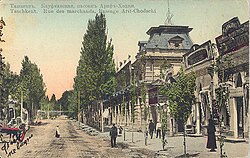Tashkent
Tashkent (Uzbek: Toshkent or Тошкент, Russian: Ташкент) is the capital city of Uzbekistan. It is also the most populated city in Central Asia, with a population of 2,603,000 in 2023.[1] Its name means "Stone City" in English.
 |
Tashkent has been inhabited by people for thousands of years.[2] It was destroyed by Genghis Khan in 1219, but later profited from the Silk Road. Tashkent was conquered by the Russian Empire in 1865, and became the capital of Russian Turkestan.[3] Under the Soviet Union, Tashkent grew in population.
In 2008, Uzbeks accounted for 63% of the population, and the city has large minorities of Russians, Tatars, Koreans, and Tajiks.
Geography
Tashkent is west of the Altai Mountains,[4] and is next to the Chirchiq River. Tashkent is situated at around 430 m (1,411 ft) above sea level. Tashkent also suffers from earthquakes, and the major 1966 earthquake destroyed most of the city.[5]
Tashkent has a mediterranean climate with continental climate influences.[6] Winters are cold and snowy, while summers are hot, sunny, and dry.[7] The record high temperature was 44.6 °C (112.3 °F), and the record low temperature was −29.5 °C (−21.1 °F).[8] The city has an average of 427 mm (17 inches) of precipitation each year.[8]
Main sights
Tashkent is full is historical sights, and this article will just mention a few.
The Amir Timur Museum was opened in 1996, and is dedicated to Mongol conqueror Timur. There are at least 5,000 artifacts on display at the museum. Around 2 million people visit the location each year, and the museum is featured on the 1,000 soʻm bank note. The museum is located downtown next to the Amir Temur Square.
The Kukeldash Madrasah (Tashkent) is an ancient madrasa located close to the Chorsu metro station. It was built in the 16th century during Shaybanid rule.[9] Throughout its existence, it functioned as a caravanserai, museum, and fortress. It was one of the few buildings to survive the 1966 earthquake.
The Navoi Theater, formally the Alisher Navoi Opera and Ballet Theatre, is the possibly the most notable opera house and theatre in Uzbekistan. It was designed by Alexey Shchusev, who also designed Lenin's Mausoleum in Moscow. It was partially built by the Japanese prisoners of war from 1945 to 1947.[10] The theatre can house at least 1,400 spectators.
Sports
Tashkent is home to some of the most successful Uzbek football clubs. These include Pakhtakor Tashkent, Lokomotiv Tashkent, Bunyodkor, and Spartak Tashkent.
Some notable athletes from Tashkent include cyclist Djamolidine Abdoujaparov, gymnast Elvira Saadi, and footballer Maksim Shatskikh.
Tashkent Media
Ambassadors from Chaganian (central figure, inscription of the neck), and Chach (modern Tashkent) to king Varkhuman of Samarkand. 648-651 CE, Afrasiyab murals, Samarkand.
Silver Dirham of Abbasid caliph Harun al-Rashid minted in Tashkent (Mad'an al-Shash) in 190 AH (805/806 CE)
Alexander Nevsky Cathedral was built by the Russian Orthodox Church in Tashkent.
The Courage Monument (Jasorat) in Tashkent on a 1979 Soviet stamp. In the background: the Friendship of the Peoples Museum building (since 1996—Museum of Olympic Glory)
References
- ↑ "Tashkent, Uzbekistan Metro Area Population 1950-2023". www.macrotrends.net. Retrieved 2023-06-02.
- ↑ "Юбилей Ташкента. Такое бывает только раз в 2200 лет". Фергана - международное агентство новостей. Retrieved 2017-12-10.
- ↑ Malikov A., The Russian conquest of the Bukharan Emirate: military and diplomatic aspects in Central Asian Survey, Volume 33, Issue 2, 2014, pp. 180–198.
- ↑ "Exploring the Cities of Uzbekistan". expatify.com. 2010-06-10. Archived from the original on 2017-02-27. Retrieved 2017-02-26.
- ↑ Cowan, Janice (2006). A Spy's Wife: The Moscow Memoirs of a Canadian who Witnessed the End of the Cold War. James Lorimer & Company. p. 74. ISBN 978-1-55028-931-2.
- ↑ Updated Asian map of the Köppen climate classification system
- ↑ Tashkent Travel. "Tashkent weather forecast". Tashkent, Uzbekistan. Archived from the original on 29 May 2009. Retrieved 11 June 2009.
- ↑ 8.0 8.1 "Climate Data for Tashkent". Centre of Hydrometeorological Service. Archived from the original on 19 September 2016. Retrieved 28 November 2012.
- ↑ "Медресе Кукельдаш" (in Russian). Central Asia Travel. Retrieved 30 October 2015.
{{cite web}}: CS1 maint: unrecognized language (link) - ↑ McLeod, Calum (2010). Uzbekistan : the golden road to Samarkand. Mayhew, Bradley. (7th ed.). Hong Kong: Odyssey. p. 99. ISBN 9789622178236. OCLC 751737081.













